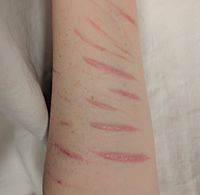
Photo from wikipedia
Importance Considerably less is known about self-injurious thoughts and behaviors (SITBs) in preadolescence than older age groups, owing partly to the common view that young children are incapable of suicidal… Click to show full abstract
Importance Considerably less is known about self-injurious thoughts and behaviors (SITBs) in preadolescence than older age groups, owing partly to the common view that young children are incapable of suicidal thoughts. Yet, preadolescent suicide has increased in recent years and is now the fifth leading cause of death in this age group, leading the National Institute of Mental Health to identify it as a priority for research and intervention. Objective To assess prevalence estimates of preadolescent SITBs, identify correlates of these outcomes, and conduct head-to-head comparisons of preadolescent and adolescent SITBs in terms of associated characteristics. Data Sources MEDLINE, PsycINFO, and Embase were systematically searched from inception through December 23, 2021, for studies on the prevalence and correlates of preadolescent SITBs. The search was restricted to English language publications and peer-reviewed journals. Study Selection Two reviewers independently identified studies providing data on prevalence and correlates of preadolescent SITBs. Data Extraction and Synthesis Two reviewers independently extracted data from each study, and the Joanna Briggs Institute Checklist for Prevalence Studies was used to assess study quality. Pooled prevalence and Cohen d were derived from random-effects meta-analyses. Preferred Reporting Items for Systematic Reviews and Meta-analyses (PRISMA) reporting guideline was followed. Main Outcomes and Measures Prevalence and correlates of suicidal ideation, suicide attempts, suicide deaths, and nonsuicidal self-injury among preadolescents. Results Fifty-eight studies with 626 486 590 individuals were included. Lifetime prevalence of suicide in the general population was 0.79 per 1 million children. Prevalence for lifetime suicidal thoughts, suicide attempts, and nonsuicidal self-injury among preadolescents were 15.1%, 2.6%, and 6.2%, respectively, in community samples. These data suggest that approximately 17.0% of preadolescents with suicidal ideation transition to attempting suicide. Across several analyses, male individuals appear more likely to have SITBs in preadolescence than adolescence. Correlate data were modest for SITBs other than suicidal ideation, but among specific disorders, attention-deficit/hyperactivity disorder (suicidal ideation: d = 0.54 [95% CI, 0.34-0.75]) and depression (suicidal ideation: d = 0.90 [95% CI, 0.71-1.09]; suicide attempts: d = 0.47 [95% CI, 0.26-0.68]) emerged as the strongest correlates. Among interpersonal factors, child maltreatment (suicidal ideation: d = 2.62 [95% CI, 1.56-3.67]) and parental support (suicidal ideation: d = -0.34 [95% CI, -0.46 to -0.22]) yielded the largest effect sizes. Conclusions and Relevance In this systematic review anda meta-analysis, although preadolescent suicide deaths were rare, other SITB types occur with concerning frequency. Male individuals were at greater risk for SITBs in preadolescence relative to adolescence. Attention-deficit/hyperactivity disorder, child maltreatment, and parental support were especially relevant to suicidal ideation, as well as depression for suicidal thoughts and behaviors, in this age group. Further study, especially of SITBs other than suicidal ideation, is needed.
Journal Title: JAMA psychiatry
Year Published: 2022
Link to full text (if available)
Share on Social Media: Sign Up to like & get
recommendations!